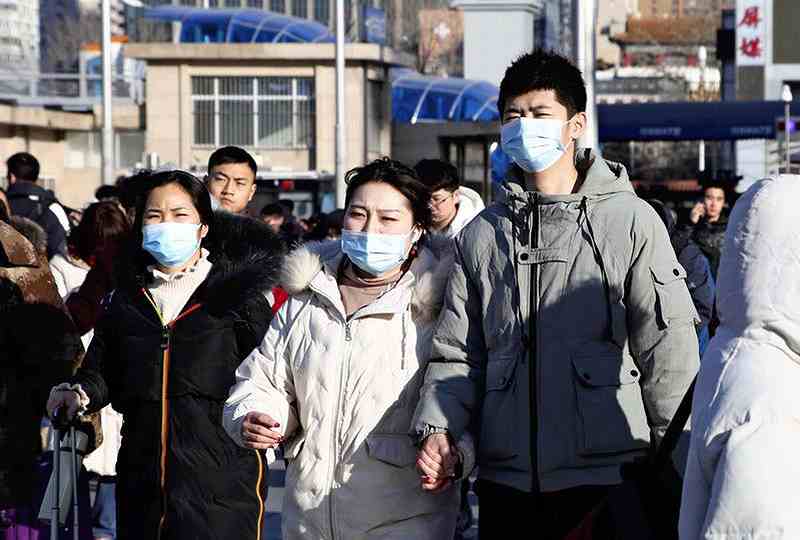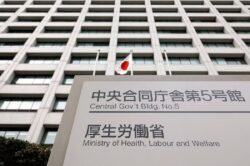
People near a train station in Beijing wear masks to prevent novel coronavirus infections on Jan. 20, 2020.
November 19, 2021
Do you remember when you first recognized the outbreak of COVID-19? Probably, we knew it with some certainty by February or March 2020 at least, when the prime minister declared school closures and the Tokyo Olympic and Paralympic Games were postponed. However, it is difficult for most of us to remember what happened at the very beginning of the outbreak because it was unclear, in many senses of the word, and was only scarcely reported in a limited number of short articles about what was at first a very local incident in Wuhan, China.
Nevertheless, as it is very important to make that unclear situation in the earliest stages clear, continuous efforts have been made to ascertain what happened and how authorities responded at the time. Additionally, recent evaluations by the Independent Panel for Pandemic Preparedness and Response and other similar committees have revealed some interesting findings on how the early warning system prepared for a global health emergency reacted at the earliest sign of the outbreak. The detailed chronology and some key facts in the early stage of the emergence of COVID-19 are starting to become clear.
‘Picked up 1st article’
The World Health Organization website Epidemic Intelligence from Open Sources (EIOS) states the following about the COVID-19 emergency:
“The EIOS system picked up the first article reporting on a cluster of pneumonia in Wuhan at 03:18am (UTC) on 31 December 2019.”
EIOS, as the name suggests, is a system that detects signs of public health emergencies by monitoring online open sources such as news reports, official statements and tweets. The above moment is the earliest response for the WHO on the current COVID-19 crisis, so the organization calls it a “key action.”
EIOS is a major system for event-based surveillance, a relatively newer surveillance concept that tracks relevant events chronologically through internet-based monitoring in real time. It is believed to be a more suitable tool for rapid detection of a public health emergency than conventional indicator-based surveillance, such as counting the number of positive tests per day and area.
No record of China’s notification
In early April 2020, the WHO and China’s government each published a timeline on COVID-19 responses for the first time. At the early stage through March, there was no chronologically detailed official information on the responses to the Wuhan cluster and the subsequent events.
The EIOS website was also published at almost the same time as the WHO’s first timeline.
The U.S. Congressional Research Service published a report on May 13 with a very detailed timeline based on various open sources. The WHO’s Western Pacific Regional Office, which covers Japan and China, followed by publishing its timeline on May 18, and other regional offices did so as well. The WHO published an updated version of its timeline on June 29, 2020, and continues to update the subsequently built interactive version.

At any sign of a Public Health Emergency of International Concern (PHEIC), WHO member states are supposed to notify the focal point of their WHO regional office within 24 hours after assessment using International Health Regulations criteria, as mandated in the IHR amended in 2005. So far, none of these timelines give the time China notified the WHO, even through Dec. 31, 2019, when the WHO detected the sign of the Wuhan cluster by itself using EIOS. The Independent Panel and IHR Review Committee, in their chronological analyses in reports submitted to the World Health Assembly in May 2021, also acknowledged this context that existed during the pandemic’s early stage. Some news reports say China notified the WHO on Dec. 31, 2019, but there is no record to prove such action took place.
Alternative China media led way
During a press conference at WHO headquarters on April 20, 2020, WHO senior official Dr. Mike Ryan said what EIOS picked up on Dec. 31, 2019, was an email posted by ProMED, a U.S.-based mailing list used as a global early warning system to monitor an emerging infectious disease or health emergency. The WHO timeline (version as of June 29, 2020) clarifies the EIOS detection of ProMED on Dec. 31, 2019, and puts a link to the archived ProMED mail, which shows the text and time sent.
The ProMED mail picked up by EIOS contained two machine-translated online news reports in Chinese that were carried on the news portal site Sina. One was originally published by Yicai, China Business News, at 02:16 UTC and the other was published by 21st Century Business Herald at 03:03 UTC.
These newspapers were established relatively recently and have different roots and history from major traditional state-owned media such as Xinhua, China Central Television, or the Chinese Communist Party’s official newspaper. The two papers touted their exclusive stories created through their original coverage of Wuhan’s local health authority on Dec. 31, 2019. As some medical personnel leaked the authority’s classified “emergency notices” delivered on the afternoon of Dec. 30 that found their way onto social media soon after, reporters from these newspapers needed to confirm whether the notices were real. It is highly important that EIOS’s algorithm did not respond to social media-leaked notices, but to articles based on coverage of the local authority.
Articles forced disclosure
The Wuhan health authority finally published the first official statement on the unknown pneumonia cluster at 05:38 UTC, 1:38 p.m. Beijing time, on Dec. 31, 2019. Foreign major media in China, including The Yomiuri Shimbun, which published its first breaking news online at 03:59 UTC, started to report on the Wuhan pneumonia cluster before the statement was published. It seems that the torrent of these media reports forced the authority to disclose information as soon as possible.
The time stamp of the ProMED mail is 04:59 UTC, about 100 minutes later than the WHO’s website description of 03:18 UTC. It is contradictory. What did EIOS find at the earlier time? EIOS might have found an article, probably in Chinese, but the article may have not been cited at the press conference and the timeline due to the language barrier. Some data from a recent report on other event-based surveillance systems implies such interpretation. Though the accountability lies with the WHO on this unsolved time gap, no official has so far given a convincing explanation.
This story was written in English by the author.
"Society" POPULAR ARTICLE
-

M4.9 Earthquake Hits Tokyo, Neighboring Prefectures
-

Israeli Tourists Refused Accommodation at Hotel in Japan’s Nagano Pref., Prompting Protest by Israeli Embassy and Probe by Prefecture
-

M7.5 Earthquake Hits Northern Japan; Tsunami Waves Observed in Hokkaido, Aomori and Iwate Prefectures
-

Tsukiji Market Urges Tourists to Avoid Visiting in Year-End
-

M5.7 Earthquake Hits Japan’s Kumamoto Pref., Measuring Upper 5 Intensity, No Tsunami Expected
JN ACCESS RANKING
-

Keidanren Chairman Yoshinobu Tsutsui Visits Kashiwazaki-Kariwa Nuclear Power Plant; Inspects New Emergency Safety System
-

Tokyo Economic Security Forum to Hold Inaugural Meeting Amid Tense Global Environment
-

Imports of Rare Earths from China Facing Delays, May Be Caused by Deterioration of Japan-China Relations
-

University of Tokyo Professor Discusses Japanese Economic Security in Interview Ahead of Forum
-

Japan Pulls out of Vietnam Nuclear Project, Complicating Hanoi’s Power Plans
























